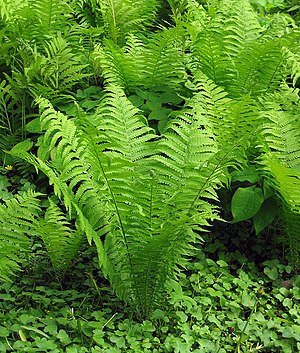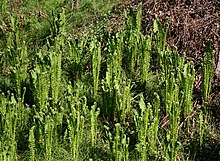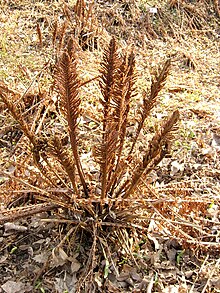Ostrich fern
| Ostrich fern | ||||||||||||
|---|---|---|---|---|---|---|---|---|---|---|---|---|

Ostrich Fern ( Matteuccia struthiopteris ) |
||||||||||||
| Systematics | ||||||||||||
|
||||||||||||
| Scientific name | ||||||||||||
| Matteuccia struthiopteris | ||||||||||||
| ( L. ) Death. |
The ostrich fern or ostrich fern ( Matteuccia struthiopteris ) is a fern from the Onocleaceae family that is also native to Central Europe . It is the only species originally found in Europe of only two species in the genus Matteuccia .
description
The ostrich fern is a perennial plant with a strong rhizome . The leaves form an upright, funnel-shaped rosette. The plant reaches a height of 30 to 150 centimeters.
The sterile leaves (trophophylls) are light green and broadly lanceolate in outline. The main leaflets are pinnate to pinnate. The innermost section, especially of the lowest leaflet, is curved in a sickle shape over the leaf spindle.
The sporophylls are clearly differentiated from the sterile leaves and are dark brown and similar to ostrich feathers when the spores are ripe. They have a linear-lanceolate outline, the main leaflets are pinnately lobed, the individual sections are rolled up. The Sori stand in two rows.
The number of chromosomes is 2n = 80.
ecology
The ostrich fern is a deciduous rosette plant that grows in a row due to its rhizome . He shows heterophyllia d. H. the outer leaves, called trophophylls , are used for photosynthesis , inner leaves, called sporophylls , are used primarily for reproduction.
The sporophylls are green at first, and they later turn brown. The spores are subject to the spread of the wind as granular fliers or they spread near the river as water scotches.
Spore ripening is from July to August.
There is a lively vegetative reproduction through over 0.5 m long, underground runners .
The ostrich fern grows in flocks on partially only weakly shaded, fresh to moist, mostly somewhat oozed, rarely flooded, low-calcium to slightly acidic, mostly base-rich and sometimes nutrient-rich, sandy-gravelly to sandy-loamy soils in floodplain forests.
Distribution and locations
The species has a circumpolar area . The distribution is described as submeridional / montane to boreal with a suboceanic focus.
The ostrich fern is a boreal to continental species that reaches the western limit of its distribution here.
The ostrich fern occurs in Europe, especially in the north: in Scandinavia, in Finland, and as far as northern Norway; in Central Europe it is found mainly east of the Rhine; in the south its area extends as far as the Western Alps and the Po Valley, it is also found in Romania and the Ukraine.
It is seldom to be found in Germany, the species is considered endangered in several federal states. This is why the ostrich fern is one of the particularly protected species in Germany. In Austria it occurs scattered; however, it is absent in Vienna and Vorarlberg, as well as in Liechtenstein.
It grows in alluvial forests, tall herbaceous meadows and on stream banks of the (collin) submontane to montane (subalpine) altitude level. It avoids lime and prefers seeping, nutrient-rich, sandy to gravelly alluvial soil. It is a character species of the Stellario-Alnetum, but also occurs in other societies of the Alno-Ulmion association and in the Tilio-Acerion.
The ostrich fern is sometimes used as an ornamental plant and also occurs in the wild. In Japan and the Maritime Provinces of Canada, young shoots that are still rolled up are also eaten as vegetables (tête de violon) .
Taxonomy
The Ostrich was in 1753 by Linnaeus in Species Plantarum under the basionym Osmunda struthiopteris first published . The epithet struthiopteris was chosen by Linné after the ostrich feather-like fertile fronds (late Latin struthio and Greek strouthion = ostrich and Greek pteris = fern).
Agostino Todaro placed the ostrich fern in 1866 in the newly created genus Matteuccia , which was named in honor of Carlo Matteucci (1811–1868), an Italian scientist who was Minister of Education in Italy in 1862.
Further synonyms are Onoclea struthiopteris (L.) Roth , Struthiopteris germanica Willd. and Struthiopteris filicastrum All.
swell
literature
- Rudolf Schubert , Klaus Werner, Hermann Meusel (eds.): Excursion flora for the areas of the GDR and the FRG . Founded by Werner Rothmaler. 13th edition. tape 2 : vascular plants . People and knowledge, Berlin 1987, ISBN 3-06-012539-2 .
- Oskar Sebald, Siegmund Seybold, Georg Philippi (Hrsg.): The fern and flowering plants of Baden-Württemberg . tape 1 : General Part, Special Part (Pteridophyta, Spermatophyta): Lycopodiaceae to Plumbaginaceae . Eugen Ulmer, Stuttgart (Hohenheim) 1990, ISBN 3-8001-3309-1 , pp. 158-160 .
- Erich Oberdorfer : Plant-sociological excursion flora . With the collaboration of Theo Müller. 7th, revised and expanded edition. Eugen Ulmer, Stuttgart (Hohenheim) 1994, ISBN 3-8252-1828-7 .
- Siegmund Seybold (Ed.): Schmeil-Fitschen interactive . CD-ROM, version 1.1. Quelle & Meyer, Wiebelsheim 2002, ISBN 3-494-01327-6 .
- Manfred A. Fischer, Wolfgang Adler, Karl Oswald: Excursion flora for Austria, Liechtenstein and South Tyrol . 2nd, improved and enlarged edition. State of Upper Austria, Biology Center of the Upper Austrian State Museums, Linz 2005, ISBN 3-85474-140-5 .
- Ruprecht Düll , Herfried Kutzelnigg : Pocket dictionary of plants in Germany and neighboring countries. The most common Central European species in portrait. 7th, corrected and enlarged edition. Quelle & Meyer, Wiebelsheim 2011, ISBN 978-3-494-01424-1 .
- Oskar Sebald, Siegmund Seybold, Georg Philippi (Hrsg.): The fern and flowering plants of Baden-Württemberg. Volume 1: General Part, Special Part (Pteridophyta, Spermatophyta): Lycopodiaceae to Plumbaginaceae . 2nd, supplemented edition. Eugen Ulmer, Stuttgart 1993, ISBN 3-8001-3322-9 .
Individual evidence
- ^ Erich Oberdorfer : Plant-sociological excursion flora for Germany and neighboring areas . With the collaboration of Angelika Schwabe and Theo Müller. 8th, heavily revised and expanded edition. Eugen Ulmer, Stuttgart (Hohenheim) 2001, ISBN 3-8001-3131-5 , pp. 74-75 .
- ^ Tete de violon. Wikibouffe (French, accessed May 20, 2016).
- ↑ Carl von Linné: Species Plantarum. Volume 2, Lars Salvius, Stockholm 1753, p. 1066, digitized .
- ↑ Lotte Burkhardt: Directory of eponymous plant names . Extended Edition. Botanic Garden and Botanical Museum Berlin, Free University Berlin Berlin 2018. [1]
Web links
- Ostrich fern. In: FloraWeb.de.
- Ostrich fern . In: BiolFlor, the database of biological-ecological characteristics of the flora of Germany.
- Profile and distribution map for Bavaria . In: Botanical Information Hub of Bavaria .
- Matteuccia struthiopteris (L.) death. In: Info Flora , the national data and information center for Swiss flora .
- Distribution in the northern hemisphere from: Eric Hultén, Magnus Fries: Atlas of North European vascular plants. 1986, ISBN 3-87429-263-0 at Den virtuella floran. (swed.)
- Thomas Meyer: Data sheet with identification key and photos at Flora-de: Flora von Deutschland (old name of the website: Flowers in Swabia )



